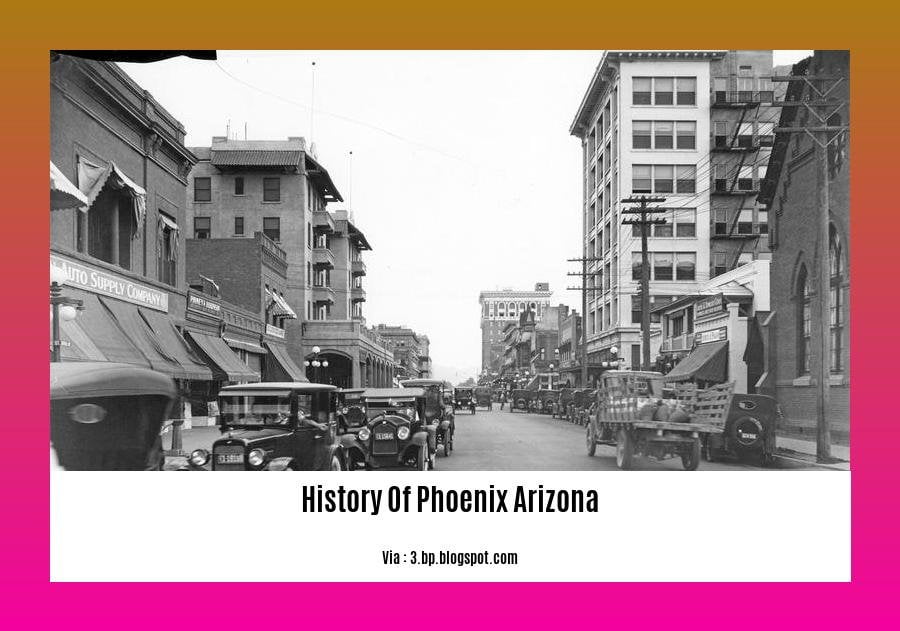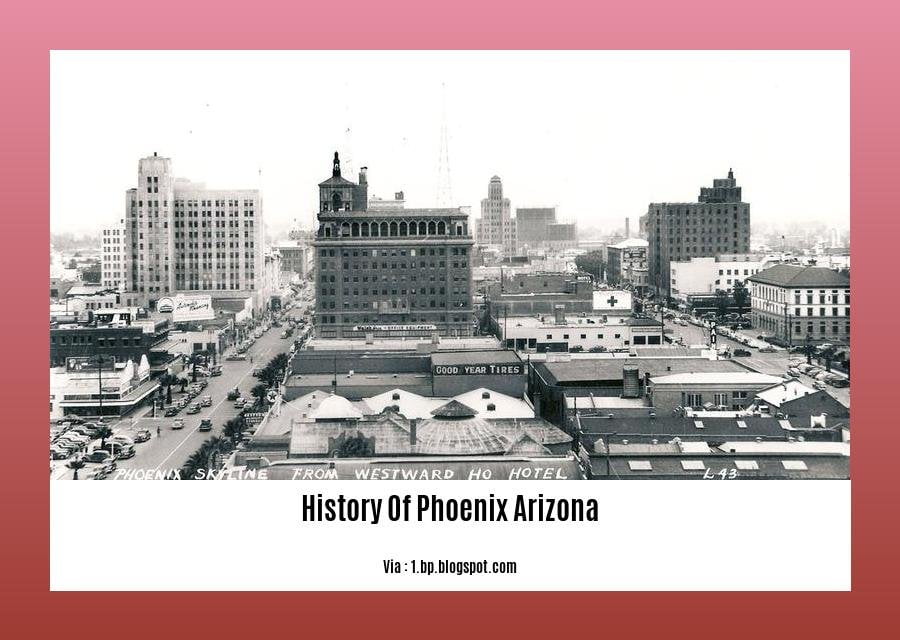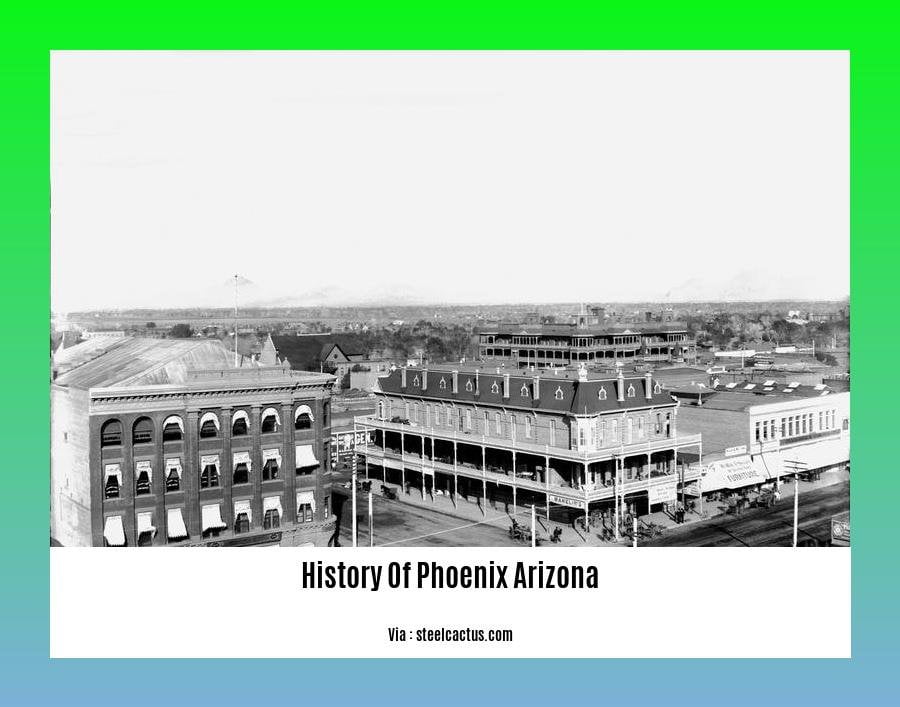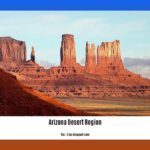Embark on a captivating journey through time as we delve into the rich history of Phoenix, Arizona, a city that has risen from the ashes like a majestic phoenix. From its humble beginnings as a small agricultural town to its transformation into a vibrant metropolis, Phoenix holds a treasure trove of stories waiting to be uncovered. Join us as we explore the iconic landmarks, unravel the intriguing tales of its past, and celebrate the diverse cultural heritage that makes Phoenix a truly special place.
Key Takeaways:
- Phoenix, Arizona, an agricultural community near the junction of the Salt and Gila Rivers, was founded in 1867.
- It became the capital of Arizona Territory in 1889.
- Phoenix rapidly evolved into a farming and commerce center in the desert Southwest.
- Its population steadily increased in the early 20th century.
- Located in the Sonoran Desert’s northeastern section, Phoenix features a hot desert climate.
History of Phoenix Arizona

Phoenix, Arizona, a thriving metropolis nestled in the heart of the Sonoran Desert, did not always exude the grandeur it does today. Picture this: the year is 1867. A small community of settlers, drawn by the promise of fertile soil and abundant water, settled near the junction of the Salt and Gila Rivers. Thus began the humble origins of what would one day become a bustling city, a beacon of progress in the arid lands of the Southwest.
A Historical Melting Pot
As the 19th century drew to a close, Phoenix’s destiny took a pivotal turn. In 1889, it was designated as the capital of the newly formed Arizona Territory. This elevation marked the beginning of a remarkable transformation. Phoenix rapidly evolved into a vibrant hub for agriculture and commerce, its strategic location attracting settlers and entrepreneurs from far and wide.
The Phoenix Rises
The early 20th century witnessed a period of unprecedented growth for Phoenix. The city’s population soared, fueled by the arrival of ambitious individuals seeking new opportunities in this burgeoning frontier. With each passing decade, Phoenix shed its frontier town image and embraced its role as a modern metropolis.
A Desert Oasis Takes Shape
Phoenix’s growth was not without its challenges. Situated in the midst of a unforgiving desert, the city had to contend with extreme temperatures and limited water resources. However, through ingenuity and perseverance, Phoenix’s pioneers found creative ways to overcome these obstacles. They developed innovative irrigation systems, transforming the barren landscape into a verdant oasis.
A City United by its Past
Today, Phoenix stands as a testament to the indomitable spirit of its early settlers. The city’s rich history is intricately woven into its tapestry of diverse cultures, iconic landmarks, and the stories of those who shaped its destiny. From its humble beginnings as an agricultural community to its current status as a thriving metropolis, Phoenix’s journey has been one of resilience, innovation, and unwavering determination.
Phoenix Through the Decades
1867: Settlement near the Salt and Gila Rivers
1889: Phoenix becomes the capital of Arizona Territory
1912: Arizona becomes a state
1920s: Population boom driven by agriculture and tourism
1950s: Rapid growth and modernization of the city
1960s: Construction of major landmarks like the Phoenix Civic Plaza
1990s: Sun Valley Freeway completed, connecting Phoenix to Scottsdale
2000s: Emergence as a major business and cultural hub
A Journey Through Time
In every corner of Phoenix, history comes alive, inviting visitors and residents alike to embark on a captivating journey through time. From the iconic Arizona State Capitol, a testament to the city’s political legacy, to the Heard Museum, showcasing the rich heritage of Native American tribes, the city is a treasure trove of historical landmarks.
And let’s not forget the Roosevelt Row Arts District, where vibrant murals adorn the walls, telling stories of Phoenix’s past and present.
Preserving the Past, Embracing the Future
Phoenix takes pride in preserving its historical legacy while embracing the future with open arms. Through initiatives like the Historic Preservation Office, the city is committed to safeguarding its architectural heritage, ensuring that future generations can appreciate the unique character that defines Phoenix.
Conclusion
As Phoenix continues to evolve, its history remains an integral part of its identity. From its humble beginnings as a small settlement to its current status as a thriving metropolis, Phoenix’s story is one of resilience, innovation, and unwavering determination. It is a city that has risen from the desert, a shining example of how the past can shape the future.
Have you wondered how Philippine fashion evolved throughout history? Embark on a captivating journey into the past as we unravel the fascinating history of Philippine fashion. You’ll discover how traditional textiles, indigenous influences, and global trends shaped the unique styles that we see today.
Mysteries surround the legendary beauty of Puerto Galera, a paradise within a tropical haven. Delve into the depths of time as we uncover the history of Puerto Galera, a narrative woven with myths, folklore, and historical landmarks. Explore the origins of its enchanting name, the stories of its indigenous people, and the events that transformed it into the captivating destination it is today.
**Tales of Transformation: How Phoenix Endured and Thrived Through Economic Shifts and Historical Events**

In the vibrant heart of the Sonoran Desert, a city has risen like a majestic phoenix from the ashes of time, embodying resilience and innovation at every turn. Phoenix, Arizona, has undergone a remarkable journey of transformation, weaving a tapestry of stories that showcase its unwavering spirit in the face of economic shifts and historical events.
Narratives of Ingenuity: Adapting to a Changing Economy
Phoenix’s tale is a testament to the human capacity for adaptation and innovation. In the early 1900s, when the agricultural economy faltered, the city pivoted towards tourism, capitalizing on its warm climate and scenic landscapes. Later, as technology transformed the global economy, Phoenix embraced its role as a hub for aerospace, healthcare, and electronics industries, becoming a beacon of progress in the digital age.
The Great Depression: Embracing Opportunity Amidst Adversity
In the depths of the Great Depression, when cities across the nation struggled, Phoenix found opportunity in the midst of adversity. The construction of the Hoover Dam, a massive infrastructure project, brought jobs and economic relief to the region, showcasing the city’s resilience and its ability to thrive even in the most challenging times.
Water Wars and Scarcity: Overcoming Nature’s Challenges
Phoenix’s location in the arid desert presented unique challenges, particularly in terms of water scarcity. Through ingenuity and determination, the city invested in innovative water conservation strategies, built dams to capture and store precious rainwater, and developed extensive canal systems to distribute water efficiently, transforming the desert into a thriving oasis.
Key Takeaways:
- Phoenix’s journey showcases its adaptability and resilience in the face of economic shifts and historical challenges.
- The city’s transformation from an agricultural hub to a technology and innovation powerhouse demonstrates its ability to embrace new opportunities.
- Phoenix’s innovative spirit is evident in its successful navigation of the Great Depression and its triumph over water scarcity.
- The city’s rich history is a testament to human ingenuity and the power of collaboration in overcoming obstacles.
Citations:
[1] The Phoenix Project: A Novel about IT, DevOps, and Helping Your Business Win by Gene Kim, Kevin Behr, and George Spafford
[2] The Phoenix Transformation: 12 Qualities of High Achievers to Accelerate Your Success by Amy Vetter
The Cultural Tapestry of Phoenix: A Vibrant Blend of Native American, European, and Mexican Heritage
Phoenix, beloved as the “Valley of the Sun,” draws its cultural richness from a symphony of Native American, European, and Mexican influences. This vibrant tapestry is woven with the threads of ancient traditions, passionate celebrations, and architectural wonders.
A Native Tapestry: Honoring Indigenous Heritage
Phoenix lovingly embraces its Native American heritage, with the proud Salt River Pima-Maricopa Indian Community gracing its landscape. The Heard Museum, a treasure trove of over 75,000 Southwestern Native American artifacts, stands as a testament to the artisanship and cultural depth of this community. Talking Stick Resort, a modern marvel of a casino and resort, dazzles visitors with its extensive collection of American Indian artwork.
European Elegance: A Symphony of Architectural Heritage
The European influence is etched into Phoenix’s architecture, with landmarks like the Arizona Biltmore Resort and Spa, a masterpiece of Frank Lloyd Wright, taking center stage. The Phoenix Art Museum, with its collection of European masterworks, offers a journey through time and artistic traditions.
Mexican Delights: A Fiesta of Flavors and Traditions
The vibrant Mexican culture infuses Phoenix with an irresistible zest for life. The city’s streets come alive with colorful murals, bustling shopping districts, and tantalizing aromas wafting from authentic Mexican restaurants. The annual Cinco de Mayo festival showcases the vibrant Mexican heritage with music, dance, art, and the tantalizing taste of traditional Mexican cuisine.
Key Takeaways:
-
Phoenix’s cultural tapestry is a colorful blend of Native American, European, and Mexican influences.
-
The Heard Museum and Talking Stick Resort offer unique insights into Native American heritage and art.
-
The European influence is reflected in landmarks like the Arizona Biltmore and the Phoenix Art Museum.
-
Mexican culture thrives in Phoenix through vibrant festivals like Cinco de Mayo and authentic Mexican cuisine.
-
The city embraces its diverse heritage through events, festivals, and landmarks.
References:
Experience American Indian Culture in Phoenix
Unveiling Arizona’s Indigenous Legacy: Explore the Vibrant Native American Culture
Modern-Day Marvel: Phoenix as a Thriving Center for Technology, Innovation, and the Arts
From the golden sands of the desert rises a city that pulses with innovation, creativity, and technological prowess: Phoenix, Arizona. This once-sleepy desert town has undergone a remarkable transformation, emerging as a thriving hub for cutting-edge technology, groundbreaking innovation, and vibrant arts.
A City Transformed: Embracing the Digital Frontier
In recent years, Phoenix has attracted major investments in computer chip manufacturing, electric vehicles, and autonomous vehicles, solidifying its position as a technology powerhouse. Tech giants like Intel, TSMC, and Lucid Motors have set up shop in the city, drawn by a favorable business environment, skilled workforce, and supportive regulatory framework.
Innovation Ecosystem: Nurturing Creativity and Growth
Phoenix boasts a thriving innovation ecosystem, providing a fertile ground for startups, incubators, and accelerators. The city’s strategic location in the Southwest, with access to major transportation hubs and a large consumer market, makes it an attractive destination for businesses seeking to tap into the region’s growing economic vitality.
Arts and Culture: A Vibrant Tapestry
Beyond technology and innovation, Phoenix is also a thriving center for the arts. The city’s vibrant arts scene features renowned institutions like the Phoenix Art Museum, the Heard Museum, and the Arizona Opera, showcasing a diverse range of artistic expressions, from contemporary masterpieces to Native American art and world-class performances.
Key Takeaways:
- Phoenix has emerged as a major hub for technology and innovation, attracting investments in computer chip manufacturing, electric vehicles, and autonomous vehicles.
- The city offers a favorable business environment, skilled workforce, and supportive regulatory framework, making it attractive to tech companies.
- Phoenix’s growing tech ecosystem nurtures startups, incubators, and accelerators, providing a supportive environment for entrepreneurs.
- The city’s strategic location in the Southwest, with access to major transportation hubs and a large consumer market, makes it an attractive destination for businesses.
- Phoenix is also a thriving center for the arts, with renowned institutions like the Phoenix Art Museum and the Heard Museum showcasing diverse artistic expressions.
Sources:
- Phoenix is emerging as the city of the future
- How Phoenix embraced digital possibilities to create a smart city.
FAQ
Q1: What were the early industries that shaped Phoenix’s growth?
A1: Phoenix’s early industries focused on agriculture and commerce, capitalizing on its strategic location near the Salt and Gila Rivers. Farming, ranching, and trading flourished, establishing the city as a hub for economic activity in the desert Southwest.
Q2: How did Phoenix become the capital of Arizona Territory?
A2: Phoenix’s rise to prominence as the capital of Arizona Territory in 1889 was a result of its strategic location and growing influence as a center for agriculture and commerce. Its central position in the territory and its accessibility via transportation routes made it an ideal choice for the territorial seat of government.
Q3: What were some of the key factors that contributed to Phoenix’s rapid growth in the early 20th century?
A3: Phoenix’s rapid growth in the early 20th century was fueled by several factors, including the construction of the Roosevelt Dam, which provided reliable water resources for agriculture and urban development. The expansion of the tourism industry, attracted by the city’s warm climate and scenic surroundings, also played a significant role in boosting Phoenix’s economy and population.
Q4: How did Phoenix’s location in the Sonoran Desert influence its development?
A4: Phoenix’s unique location in the northeastern part of the Sonoran Desert has had a profound impact on its development. The hot desert climate brought challenges such as water scarcity and extreme temperatures, which the city overcame through innovative water management systems and architectural adaptations. The desert environment also influenced the city’s economy, leading to the development of industries related to tourism, agriculture, and renewable energy.
Q5: What are some of the significant cultural influences that have shaped Phoenix’s identity?
A5: Phoenix’s cultural identity has been shaped by a blend of Native American, Western, and Hispanic influences. The city is home to the Heard Museum, which houses a vast collection of Southwestern Native American art and artifacts. The strong Western heritage is reflected in the city’s cowboy culture, rodeos, and annual events like the Scottsdale Arabian Horse Show. The Hispanic influence is evident in the city’s cuisine, music, and festivals, showcasing the vibrant Latino community that contributes to Phoenix’s diverse cultural landscape.















